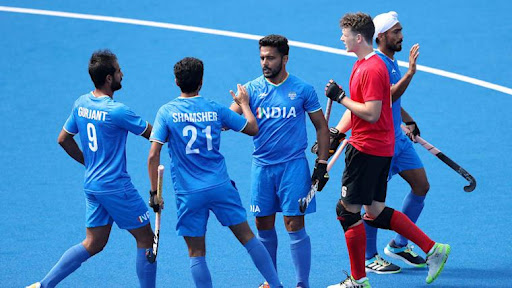Is the Indian Men’s Hockey Team on the resurgence once again?

Indian hockey has an illustrious history; Until the 1950s, India was the most successful hockey nation in the world, with 8 Olympic gold medals.
However, with the rise of European nations such as Germany, England, the Netherlands, Spain, and Belgium, as well as other teams such as Korea, Australia, and Pakistan, India’s position as a world hockey superpower has gradually but steadily declined.
They began to lose to these teams on a consistent basis, finishing outside the medals bracket in the Olympics and World Cups.
Cause of decline
The switch from grass to Astro-Turf, as well as the introduction of new skills such as drag flicking in penalty corners, did not help India’s cause.
The grass pitches were ideal for Indian players known for their passing and dribbling skills. However, AstroTurf favoured the physicality of European and Australian players.
These grounds are costly to keep up. The Indian Hockey Federation lacked sufficient funds. Authorities shaved the grass and plastered the field with cow dung in preparation for the 1976 Montreal Olympics.
Without a doubt, it failed, and we returned empty-handed. India did win a gold medal at the 1980 Moscow Olympics, but the West did not compete in order to protest the Soviet invasion of Afghanistan.
Rule changes such as the elimination of offside play in 1992, the allowance of overhead shots, and no cap on rolling substitutes, among others, all contributed to the decline, and players took time to adjust. The pace of the game increased. Individual brilliance was replaced by fitness and tactical play.
These modifications completely altered the game’s dynamics. Speed and penalty corner conversion was more important in hockey than skilled dribbling, which was India’s strength. As a result, European teams such as the Netherlands and Germany began to dominate world hockey because they played a fast-paced game and were much fitter than the other nations.
Pakistan, the other Asian hockey powerhouse, was able to outperform India until the 1990s thanks to great penalty corner specialists like Sohail Abbas, who mastered the art of scoring goals from drag flicks.
India took longer to adjust to these changes than the other top hockey nations. As a result, their performances suffered even further. After winning the 1980 Moscow Olympics, India went 35 years without winning a major international hockey tournament.
The lowest point in Indian hockey history occurred in 2008 when India failed to qualify for the Olympics for the first time.
Steps taken to stall the decline
India also finished third in the 2020 Tokyo Olympics
This was a wake-up call for the Indian hockey community. They finally realised that fundamental changes and a concentrated youth development programme were required. Foreign coaches, in addition to our Indian coaches, were required to expose our players to the most recent developments in world hockey.
As a result of these realisations, some positive steps were taken. In 2013, a professionally run hockey league was established, in which the best players from around the world competed against our Indian players.
Although this league ended in 2017, it had some positive effects. Because of their exposure, it produced a group of players who were more confident in competing and winning against the best teams in the world. They also learned new modern hockey skills such as 3D dribbling and drag flicking.
As a result of this league, India’s pool of talented players has grown. In each position, there were more than one or two international calibre players. Multiple options for a particular position are very important in this era of modern hockey, where there is rolling substitution.
Also came the major push in the form of the Odisha government led by Naveen Patnaik. They became the only state government to sponsor a national team in 2018. Previously, the Odisha government hosted the Champions Trophy in 2014 and the World Hockey League Finals in 2017.
The Odisha Naval Tata Hockey High-Performance Centre at the Kalinga Stadium in Bhubaneswar is a prime example of the government’s efforts. The centre was built in collaboration with the TATA group to provide all athletes with world-class sporting facilities.
All of these efforts off the field have resulted in an encouraging performance on the field, and the results are visible to all.
Both the men’s and women’s teams showed that they belonged right there with the big boys and girls.
Present State
India now has a good pool of young and talented players
India now has a good pool of young and talented players who understand how to play modern hockey. There are three or four world-class drag-flickers in the team, including Rupinder Pal Singh, Harmanpreet Singh, Varun Kumar and Amit Rohidas, who can consistently convert penalty corners into goals, which was India’s single biggest problem in the 1990s and early part of the twenty-first century.
Furthermore, there is a very solid midfield and a dependable defence, with leaders like Manpreet Singh and Harmanpreet Singh who have the ability to control the match against any other team in the world.
With the addition of players like Akashdeep, Lalit Upadhyay, and Mandeep, India’s forward line is also quite strong. During circle penetrations, they can score field goals and earn penalty corners.
With goalkeepers like Sreejesh and Krishan Pathak in the mix, the current Indian team is a formidable force with a lot of potential.
Their results, however, have been inconsistent. They frequently have a great match one day and then look terrible the next. Furthermore, despite playing good hockey, they lost important games by conceding goals in the final few minutes.
Given the team’s quality, it is reasonable to expect that with experience, the team will become mentally stronger and perform better in larger events such as the Olympics and World Cups.
India has now risen to fifth place in the world rankings. They finished with a bronze medal in the 2020 Tokyo Olympics and followed that up by bagging silver in the recently concluded 2022 Birmingham Commonwealth Games.
What does the future hold?
The future appears to be promising. The results obtained by both teams at the Tokyo Olympics were not a fluke. There is still a lot of work to be done at the state level, and hopefully, this Olympics has gotten the right kind of attention.
Another project led by Naveen Patnaik envisions Rourkela as the site of the country’s largest hockey stadium. Odisha will also host the Men’s Hockey World Cup for the second time in 2023. In addition, the government intends to install 17 synthetic turfs in the Sundargarh district.
All of this will undoubtedly result in increased exposure and experience. The times have changed. We’ve always had the talent, legacy, history, and pedigree, but all it took was a step in the right direction, and the wheels are now in motion.
Their steady rise in the world rankings coupled with recent strong performances in global events demonstrates that they have the potential to reclaim their former glory. Only time will tell whether they are capable of doing so.


